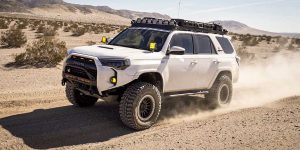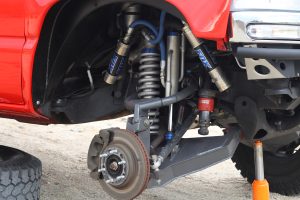When it comes to off-road driving, the terrain is anything but smooth. From rocky trails and steep inclines to muddy ruts and deep potholes, every part of your vehicle’s suspension system is put to the test — especially your shock absorbers. Unlike those used in standard road cars, off-road shock absorbers are uniquely engineered to handle extreme conditions while maintaining ride control, safety, and comfort.
This article explores the key differences in off-road shocks, how they work, and why choosing the right type can make or break your off-road experience.

What Do Shock Absorbers Actually Do?
Shock absorbers are a critical component of your vehicle’s suspension system. Their primary job is to control the rebound and compression of the suspension springs, absorbing energy from bumps and uneven surfaces to:
-
Minimize bounce and vibrations
-
Improve vehicle stability
-
Enhance traction by keeping tires in contact with the ground
-
Increase driver and passenger comfort
Without shock absorbers, your vehicle would bounce uncontrollably after every dip or bump in the road.
Why Are Off-Road Conditions So Demanding?
Off-road environments are unpredictable and dynamic. Unlike paved roads, trails and backcountry tracks throw a mix of challenges at your suspension system:
| Off-Road Challenge | Impact on Shocks |
|---|---|
| Uneven terrain & rocks | Constant compression and rebound cycles |
| Deep ruts & potholes | High-impact jolts that strain suspension |
| Mud & water crossings | Require durable, sealed shocks to avoid contamination |
| Steep climbs & descents | Shift weight distribution, increasing pressure |
| Long travel suspension needs | Requires extended range of motion and fluid control |
To cope with this, off-road shocks are built differently — from the internal fluid to the external design.
Key Differences: Off-Road vs. Standard Shock Absorbers
| Feature | Standard Shocks | Off-Road Shocks |
|---|---|---|
| Design Pressure | Lower, for smoother roads | Higher, to handle extreme loads and impacts |
| Shock Body Size | Smaller | Larger body for more fluid and cooling capacity |
| Suspension Travel | Limited | Long travel to accommodate big wheel movements |
| Heat Dissipation | Basic | Advanced cooling (reservoirs, fins, larger oil volume) |
| Durability | Lighter-duty | Heavy-duty construction for impacts and wear resistance |
| Mounting Options | Standard mounts | Custom mounts and reinforcements often required |
Types of Off-Road Shock Absorbers
Off-road shock absorbers come in several varieties, each tailored to different levels of terrain and performance.
1. Twin-Tube Shocks
-
Pros: Affordable, widely available
-
Cons: Limited performance in extreme off-road conditions
2. Monotube Shocks
-
Pros: Better cooling, quicker response
-
Cons: Slightly higher cost
3. Reservoir Shocks (Remote or Piggyback)
-
Pros: Superior cooling, high travel capacity, built for extreme terrain
-
Cons: Expensive, requires more space for installation
4. Adjustable Shocks
-
Pros: Customizable for ride height, damping, and terrain type
-
Cons: Complex to install and tune properly
| Shock Type | Best For |
|---|---|
| Twin-Tube | Light trail use, budget builds |
| Monotube | Moderate off-roading, performance upgrades |
| Reservoir | Extreme trails, rock crawling, overlanding |
| Adjustable | Versatile setups, on/off-road switching |
Features to Look for in Off-Road Shocks
Before you invest, make sure your off-road shock absorbers include the following features:
-
High-pressure gas charge – reduces foaming and improves consistency
-
Thick piston rods – resist bending and wear during impacts
-
Sealed construction – protects against mud, water, and dust intrusion
-
Heat-resistant fluid – maintains damping performance in long rides
-
Corrosion-resistant coating – prevents rust from trail exposure
Optional upgrades can include rubber bushings for noise reduction, reinforced mounting hardware, and customizable damping settings.
Benefits of Upgrading to Off-Road Shocks
Swapping your standard shocks for high-quality off-road units offers several key advantages:
Improved Handling and Control
-
Better wheel articulation and traction over rocks and uneven ground
Greater Comfort
-
Smoother ride over long distances on rough terrain
Enhanced Durability
-
Longer lifespan even under the harshest off-road conditions
Custom Tuning Potential
-
Ability to match your suspension to your driving style and vehicle weight
Maintenance Tips for Off-Road Shock Absorbers

Even the best shocks need care to last. Follow these maintenance tips:
-
Inspect after every off-road trip – Check for leaks, dents, or unusual wear
-
Clean regularly – Remove mud and debris from around seals and mounts
-
Torque mounting bolts – Ensure hardware stays tight after rough driving
-
Replace bushings as needed – Worn bushings can cause noise and play
| Maintenance Task | Frequency |
|---|---|
| Visual inspection | After every off-road run |
| Cleaning | After muddy/wet trails |
| Fluid leaks check | Monthly or before trips |
| Bushing replacement | Every 20,000–40,000 km |
Where to Buy Reliable Off-Road Shock Absorbers
Looking to upgrade your vehicle’s suspension for better off-road performance? Choose shock absorbers that are built for rugged terrains and tailored to your vehicle model.
This store offers a wide selection of high-performance shocks suitable for everything from weekend trail runs to professional-grade rock crawling. You’ll find monotube, twin-tube, adjustable, and reservoir types — all compatible with a variety of car and SUV brands. Fast shipping, easy fitment search, and quality you can trust.
Conclusion
Shock absorbers are not just a comfort feature — they’re essential to off-road safety, control, and performance. Off-road-specific shocks are designed to handle the punishing demands of nature, giving your vehicle the stability and strength it needs to conquer any trail.
Whether you’re an overlander, weekend warrior, or serious off-road competitor, upgrading your shocks is one of the best investments you can make for your vehicle. Just be sure to choose the right type for your terrain and driving needs — and don’t forget the regular maintenance to keep them performing at their best.
Ready to hit the trail? Make sure your suspension is ready, too.